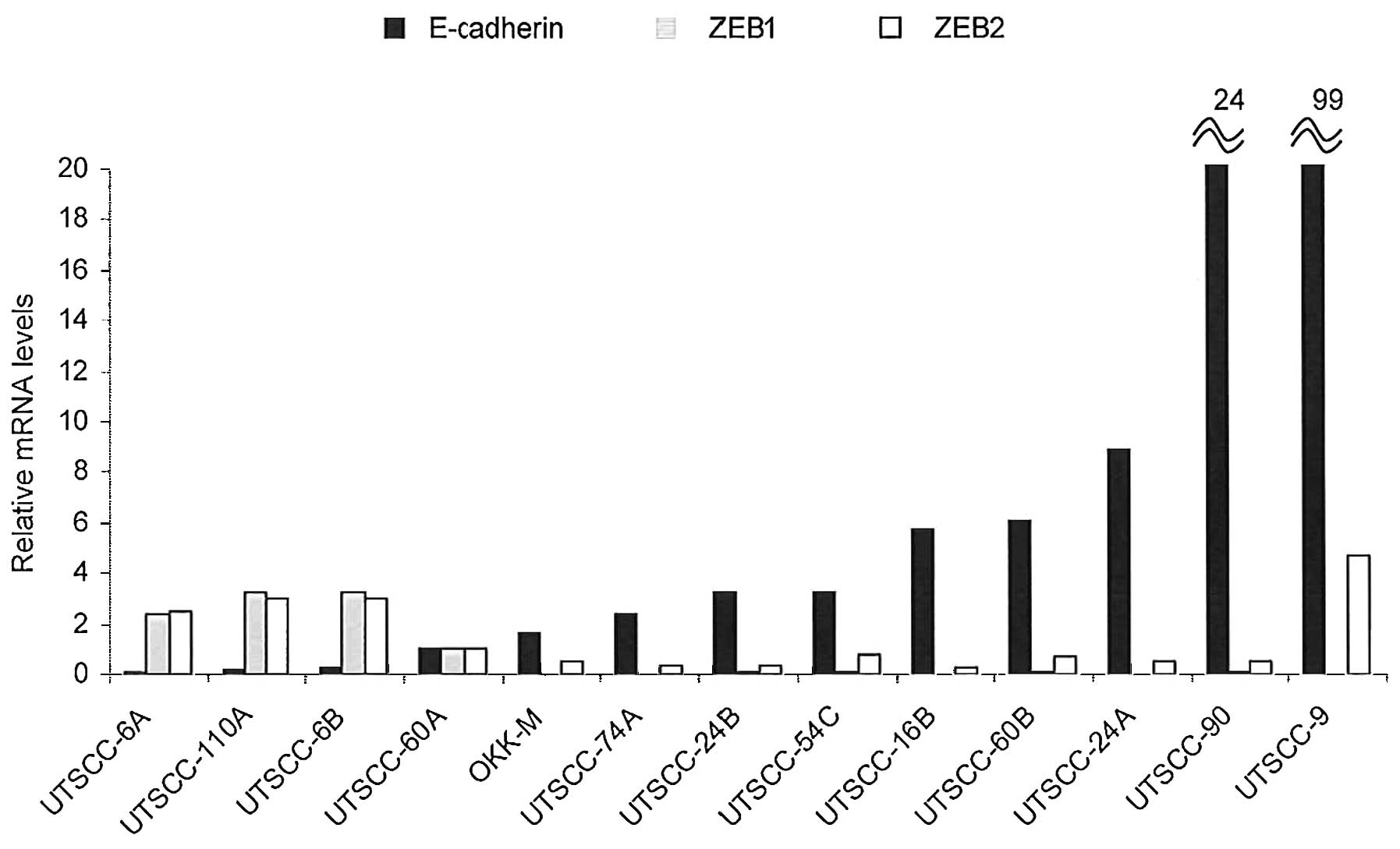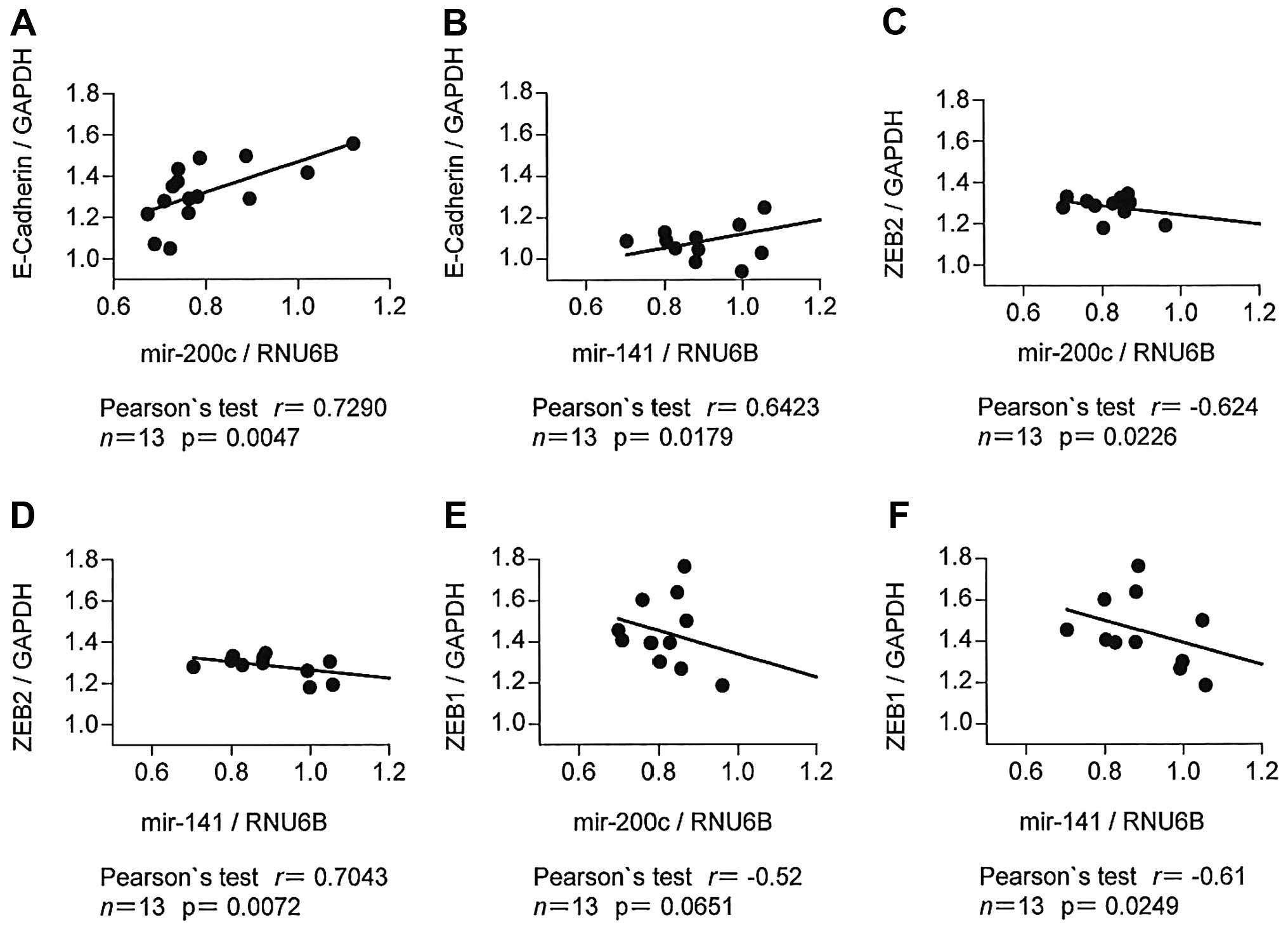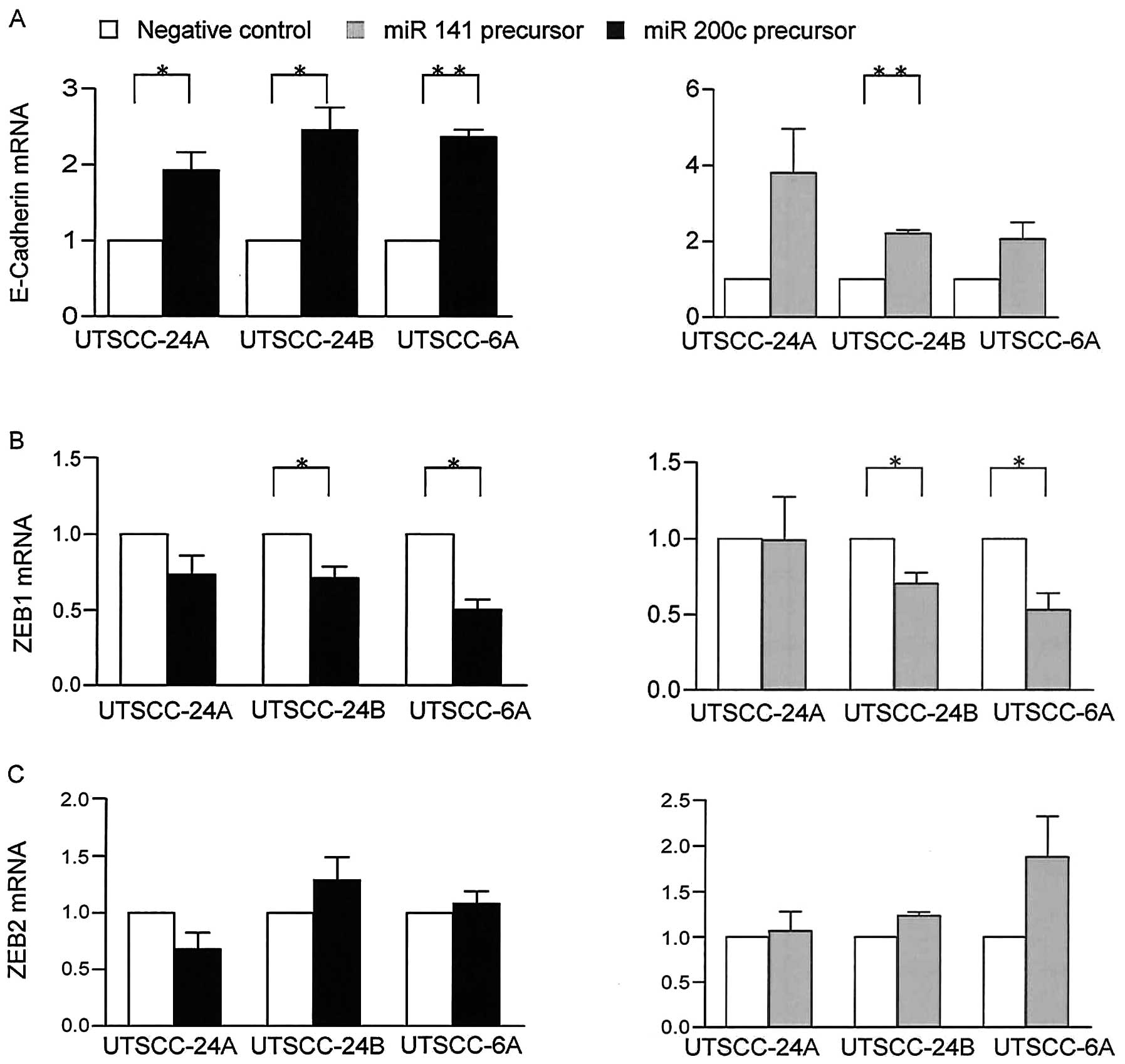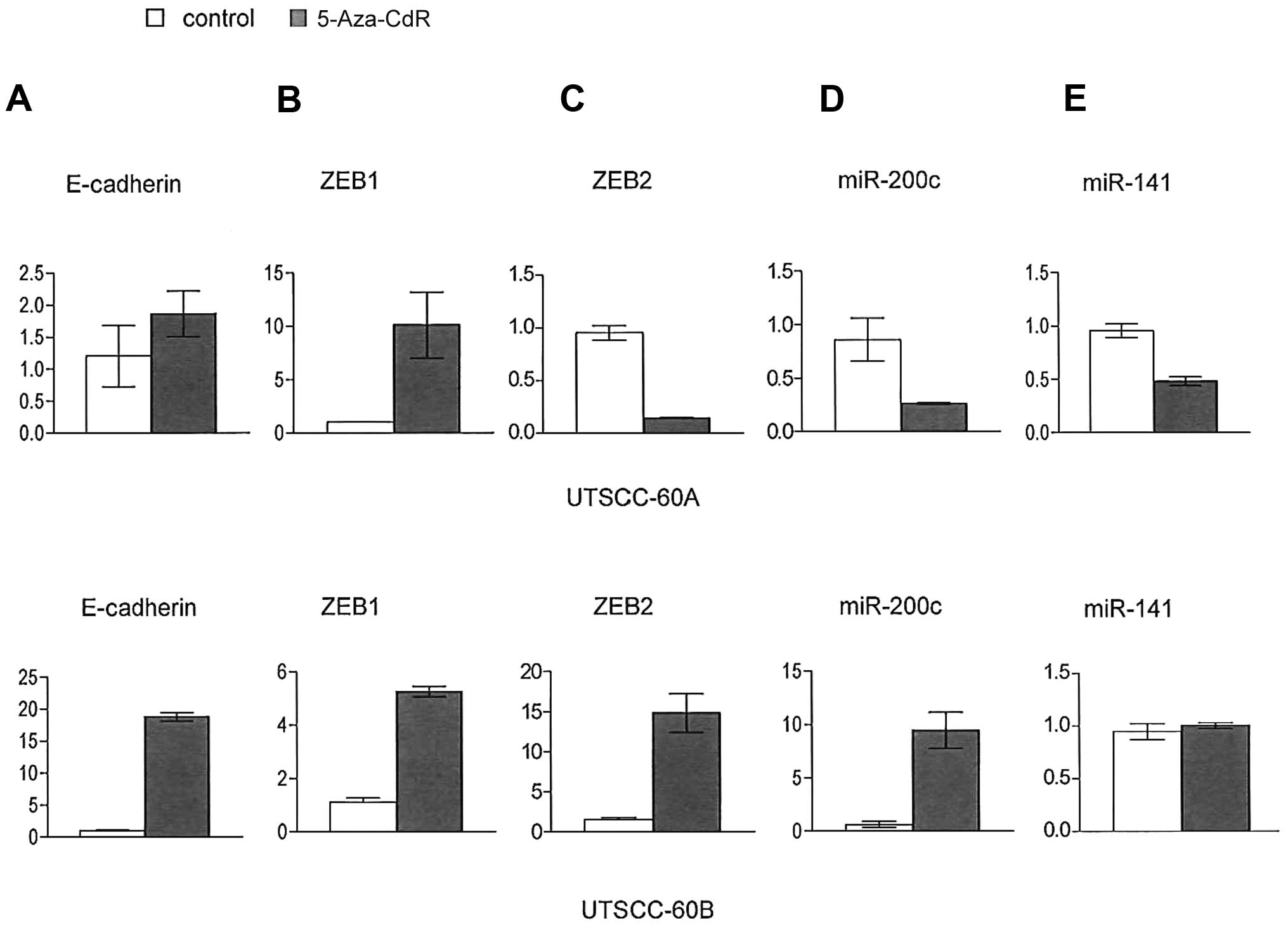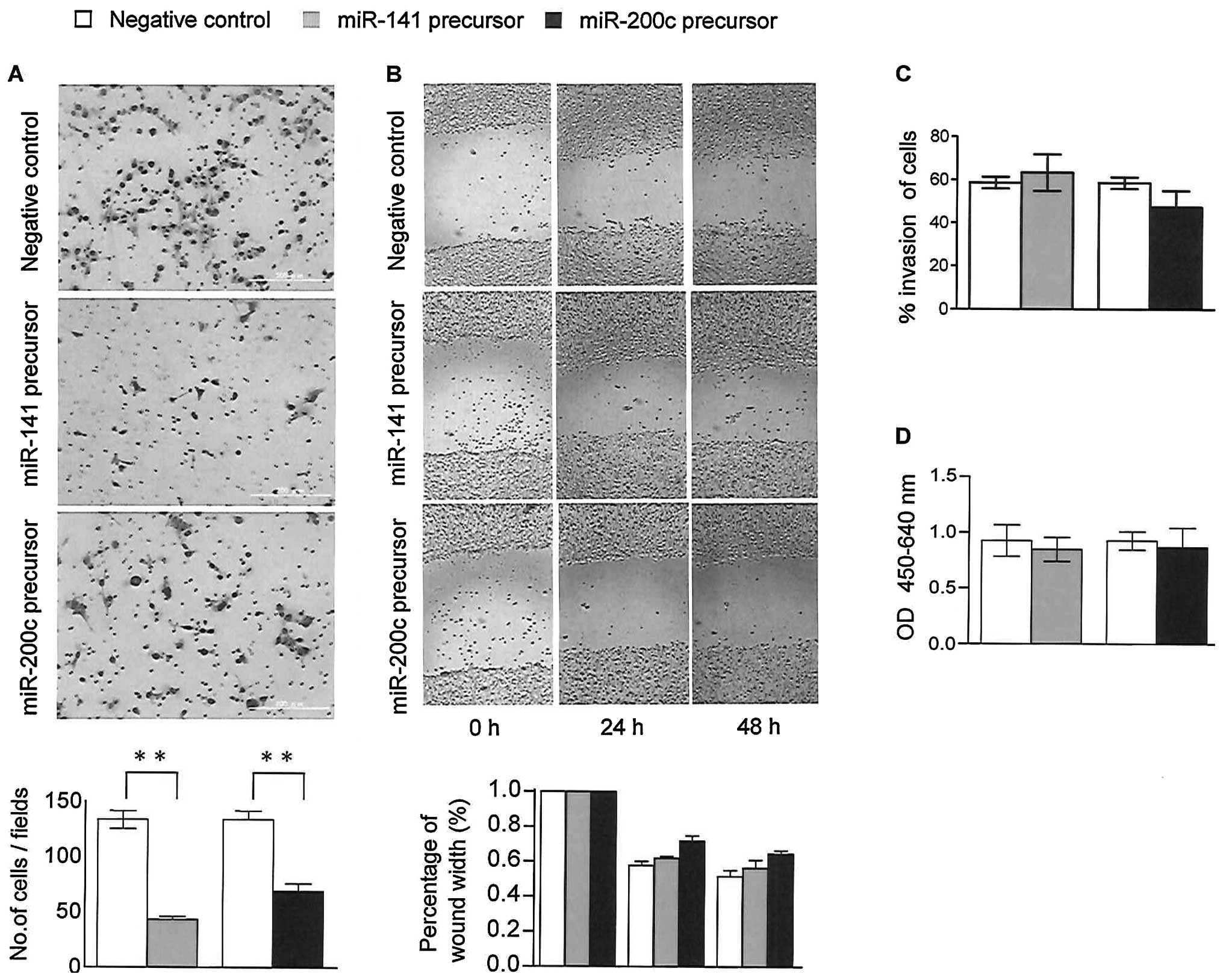|
1
|
Tsuji T, Ibaragi S and Hu GF:
Epithelial-mesenchymal transition and cell cooperativity in
metastasis. Cancer Res. 69:7135–7139. 2009. View Article : Google Scholar : PubMed/NCBI
|
|
2
|
Hill L, Browne G and Tulchinsky E:
ZEB/miR-200 feedback loop: At the crossroads of signal transduction
in cancer. Int J Cancer. 132:745–754. 2012. View Article : Google Scholar : PubMed/NCBI
|
|
3
|
Tran N, McLean T, Zhang X, Zhao CJ,
Thomson JM, O’Brien C and Rose B: MicroRNA expression profiles in
head and neck cancer cell lines. Biochem Biophys Res Commun.
358:12–17. 2007. View Article : Google Scholar
|
|
4
|
Gregory PA, Bert AG, Paterson EL, Barry
SC, Tsykin A, Farshid G, Vadas MA, Khew-Goodall Y and Goodall GJ:
The miR-200 family and miR-205 regulate epithelial to mesenchymal
transition by targeting ZEB1 and SIP1. Nat Cell Biol. 10:593–601.
2008. View
Article : Google Scholar : PubMed/NCBI
|
|
5
|
Park SM, Gaur AB, Lengyel E and Peter ME:
The miR-200 family determines the epithelial phenotype of cancer
cells by targeting the E-cadherin repressors ZEB1 and ZEB2. Genes
Dev. 22:894–907. 2008. View Article : Google Scholar : PubMed/NCBI
|
|
6
|
Brabletz S and Brabletz T: The ZEB/miR-200
feedback loop - a motor of cellular plasticity in development and
cancer? EMBO Rep. 11:670–677. 2010. View Article : Google Scholar : PubMed/NCBI
|
|
7
|
Livak KJ and Schmittgen TD: Analysis of
relative gene expression data using real-time quantitative PCR and
the 2(-Delta Delta C(T)) Method. Methods. 25:402–408. 2001.
View Article : Google Scholar : PubMed/NCBI
|
|
8
|
Beder LB, Gunduz M, Hotomi M, Fujihara K,
Shimada J, Tamura S, Gunduz E, Fukushima K, Yaykasli K, Grenman R,
Shimizu K and Yamanaka N: T-lymphocyte maturation-associated
protein gene as a candidate metastasis suppressor for head and neck
squamous cell carcinomas. Cancer Sci. 100:873–880. 2009. View Article : Google Scholar : PubMed/NCBI
|
|
9
|
Griffiths-Jones S, Grocock RJ, van Dongen
S, Bateman A and Enright AJ: miRBase: microRNA sequences, targets
and gene nomenclature. Nucleic Acids Res. 1:D140–D144. 2006.
View Article : Google Scholar : PubMed/NCBI
|
|
10
|
Vrba L, Jensen TJ, Garbe JC, Heimark RL,
Cress AE, Dickinson S, Stampfer MR and Futscher BW: Role for DNA
methylation in the regulation of miR-200c and miR-141 expression in
normal and cancer cells. PLoS One. 5:e86972010. View Article : Google Scholar : PubMed/NCBI
|
|
11
|
Wiklund ED, Bramsen JB, Hulf T, Dyrskjøt
L, Ramanathan R, Hansen TB, Villadsen SB, Gao S, Ostenfeld MS,
Borre M, Peter ME, Ørntoft TF, Kjems J and Clark SJ: Coordinated
epigenetic repression of the miR-200 family and miR-205 in invasive
bladder cancer. Int J Cancer. 128:1327–1334. 2011. View Article : Google Scholar : PubMed/NCBI
|
|
12
|
Lim YY, Wright JA, Attema JL, Gregory PA,
Bert AG, Smith E, Thomas D, Lopez AF, Drew PA, Khew-Goodall Y and
Goodall GJ: Epigenetic modulation of the miR-200 family is
associated with transition to a breast cancer stem-cell-like state.
J Cell Sci. 126:2256–2266. 2013. View Article : Google Scholar : PubMed/NCBI
|
|
13
|
Li A, Omura N, Hong SM, Vincent A, Walter
K, Griffith M, Borges M and Goggins M: Pancreatic cancers
epigenetically silence SIP1 and hypomethylate and overexpress
miR-200a/200b in association with elevated circulating miR-200a and
miR-200b levels. Cancer Res. 70:5226–5237. 2010. View Article : Google Scholar : PubMed/NCBI
|
|
14
|
Rodenhiser DI, Andrews J, Kennette W,
Sadikovic B, Mendlowitz A, Tuck AB and Chambers AF: Epigenetic
mapping and functional analysis in a breast cancer metastasis model
using whole-genome promoter tiling microarrays. Breast Cancer Res.
10:R622008. View
Article : Google Scholar : PubMed/NCBI
|
|
15
|
Acun T, Oztas E, Yagci T and Yakicier MC:
SIP1 is downregulated in hepatocellular carcinoma by promoter
hypermethylation. BMC Cancer. 11:2232011. View Article : Google Scholar : PubMed/NCBI
|
|
16
|
Hidaka T, Nakahata S, Hatakeyama K,
Hamasaki M, Yamashita K, Kohno T, Arai Y, Taki T, Nishida K,
Okayama A, Asada Y, Yamaguchi R, Tsubouchi H, Yokota J, Taniwaki M,
Higashi Y and Morishita K: Down-regulation of TCF8 is involved in
the leukemogenesis of adult T-cell leukemia/lymphoma. Blood.
112:383–393. 2008. View Article : Google Scholar : PubMed/NCBI
|
|
17
|
Su Z, Xia J and Zhao Z: Functional
complementation between transcriptional methylation regulation and
post-transcriptional microRNA regulation in the human genome. BMC
Genomics. 12(Suppl 5): S152011. View Article : Google Scholar
|
|
18
|
Wiklund ED, Gao S, Hulf T, Sibbritt T,
Nair S, Costea DE, Villadsen SB, Bakholdt V, Bramsen JB, S⊘rensen
JA, Krogdahl A, Clark SJ and Kjems J: MicroRNA alterations and
associated aberrant DNA methylation patterns across multiple sample
types in oral squamous cell carcinoma. PLoS One. 6:e278402011.
View Article : Google Scholar : PubMed/NCBI
|
|
19
|
Lo WL, Yu CC, Chiou GY, Chen YW, Huang PI,
Chien CS, Tseng LM, Chu PY, Lu KH, Chang KW, Kao SY and Chiou SH:
MicroRNA-200c attenuates tumour growth and metastasis of
presumptive head and neck squamous cell carcinoma stem cells. J
Pathol. 223:482–495. 2011. View Article : Google Scholar : PubMed/NCBI
|
|
20
|
Korpal M, Ell BJ, Buffa FM, Ibrahim T,
Blanco MA, Celià-Terrassa T, Mercatali L, Khan Z, Goodarzi H, Hua
Y, Wei Y, Hu G, Garcia BA, Ragoussis J, Amadori D, Harris AL and
Kang Y: Direct targeting of Sec23a by miR-200s influences cancer
cell secretome and promotes metastatic colonization. Nat Med.
17:1101–1108. 2011. View
Article : Google Scholar : PubMed/NCBI
|
|
21
|
Korpal M, Lee ES, Hu G and Kang Y: The
miR-200 family inhibits epithelial-mesenchymal transition and
cancer cell migration by direct targeting of E-cadherin
transcriptional repressors ZEB1 and ZEB2. J Biol Chem.
283:14910–14914. 2008. View Article : Google Scholar : PubMed/NCBI
|
|
22
|
Zidar N, Bostjancic E, Gale N, Kojc N,
Poljak M, Glavac D and Cardesa A: Down-regulation of microRNAs of
the miR-200 family and miR-205, and an altered expression of
classic and desmosomal cadherins in spindle cell carcinoma of the
head and neck - hallmark of epithelial-mesenchymal transition. Hum
Pathol. 42:482–488. 2011. View Article : Google Scholar : PubMed/NCBI
|



